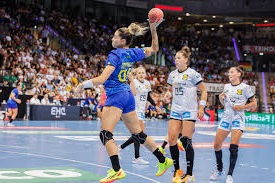What Is Handball? Rules, History, and How to Play the Fast-Paced Team Sport
Handball is an exciting, fast-paced team sport that combines the agility of basketball, the speed of soccer, and the strategy of hockey — all played with your hands. While handball is especially popular in Europe, it’s gaining recognition worldwide due to its dynamic gameplay and team-based excitement.
In this comprehensive guide, you’ll learn what handball is, its history, basic rules, positions, and why it’s becoming one of the most thrilling team sports today.
What Is Handball?
Handball is a team sport where two teams of seven players each (six outfield players and one goalkeeper) compete to score goals by throwing a ball into the opposing team’s net. The team with the most goals at the end of two 30-minute halves wins the match.
Handball is usually played indoors on a court measuring 40 meters long by 20 meters wide, with goals at each end. The game is extremely fast, with quick transitions, high jumps, and powerful throws.
History of Handball
The origins of handball can be traced back to ancient civilizations, but the modern version of the sport was developed in Denmark, Germany, and Sweden in the late 19th and early 20th centuries.
-
1906: Danish gym teacher Holger Nielsen published the first set of modern rules.
-
1925: The first international match between Germany and Austria was played.
-
1936: Handball made its Olympic debut as an outdoor sport in Berlin.
-
1972: Indoor handball was introduced to the Olympics in Munich and has been a staple ever since.
Today, handball is governed by the International Handball Federation (IHF) and is played professionally and recreationally in over 180 countries.
Basic Rules of Handball
Understanding the rules of handball is key to appreciating the sport. Here are the most important ones:
🏐 Objective of the Game
Score more goals than the opposing team by throwing the ball into their net.
⏱ Match Duration
-
2 halves of 30 minutes each
-
10-minute halftime break
👥 Team Composition
-
7 players on court: 6 field players + 1 goalkeeper
-
Substitutions are unlimited and can happen at any time
🧤 Ball Handling Rules
-
Players can hold the ball for up to 3 seconds
-
Take up to 3 steps while holding the ball
-
Dribble like in basketball, then pick up the ball and continue again (only once per possession)
❌ Fouls and Penalties
-
Physical contact is allowed but pushing, holding, or tripping is not
-
Serious fouls result in:
-
Free throws
-
7-meter penalties (similar to penalty kicks in soccer)
-
2-minute suspensions
-
Handball Court Layout
A standard handball court features:
-
Goal area: A 6-meter semi-circular zone around the goal; only the goalkeeper can be inside
-
Free-throw line: A dashed 9-meter line used for free throws
-
Center line: Where the game and second half begin
-
Goals: Each 3 meters wide and 2 meters high
Player Positions in Handball
Handball involves a mix of speed, strength, and strategy. Each position plays a critical role:
-
Goalkeeper: Defends the goal; can use any part of the body to block shots
-
Left Wing: Fast and agile; plays close to the sideline and scores from tight angles
-
Right Wing: Similar to the left wing but on the opposite side
-
Left Back: Tall, strong shooters who take long-range shots
-
Right Back: Mirror of the left back, often left-handed
-
Center Back (Playmaker): The “brain” of the offense; sets up plays and directs traffic
-
Pivot (Circle Runner): Operates around the 6-meter line; receives passes and blocks defenders
Why Handball Is So Popular
Handball is loved by fans and players alike for several reasons:
-
⚡ Fast-Paced Action: Non-stop movement and scoring make it thrilling to watch
-
🧠 Strategic Depth: Requires quick thinking and coordination
-
🤝 Team Sport: Success depends on strong teamwork and communication
-
🏃 Fitness and Agility: Improves cardiovascular health and physical endurance
-
🌍 Global Appeal: Played in schools, clubs, and national teams across continents
Handball vs. American Handball
It’s important not to confuse European handball (the team sport) with American handball, which is a 1-on-1 or 2-on-2 game similar to squash but played by hitting a small rubber ball against a wall using your hands.
This article focuses on team handball, the internationally recognized version played on a court with goals and teams.
How to Get Started with Handball
If you’re new to the sport, here’s how to start playing:
✅ Find a Club or Team
Many communities have amateur handball clubs. Check with local sports centers or schools.
✅ Basic Gear
-
Handball shoes (indoor court shoes)
-
Comfortable sportswear
-
Handball (sizes vary by age and gender)
✅ Learn the Rules
Watch games online or attend local matches to get a feel for strategies and play styles.
✅ Train Your Skills
Practice passing, dribbling, shooting, and defensive techniques. Team drills help build coordination.
Top Handball Competitions and Teams
🌍 International Tournaments
-
IHF World Championships (Men’s and Women’s)
-
Olympic Games
-
European Handball Championship
🏆 Top Clubs and Leagues
-
Paris Saint-Germain Handball (France)
-
FC Barcelona Handbol (Spain)
-
THW Kiel (Germany)
-
EHF Champions League – The premier club competition in Europe
Handball Fun Facts
-
A single handball match can see 60+ goals scored
-
Handball is one of the fastest Olympic team sports
-
The ball weighs around 450 grams (1 lb) and is slightly smaller than a soccer ball
-
France, Denmark, and Norway are dominant nations in international handball
Conclusion: Why You Should Try Handball
Handball is more than just a sport — it’s a fast, fun, and inclusive game that brings people together. Whether you want to compete at a high level, stay active, or simply enjoy a thrilling team experience, handball offers something for everyone.


You must be logged in to post a comment.